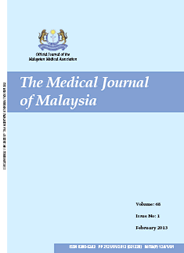MJM, Vol 70 Supplement 1 September 2015
Food Consumption Patterns: Findings from the
Malaysian Adults Nutrition Survey (MANS) 2014
Institute for Public Health, Ministry of Health Malaysia
ABSTRACT
Introduction: Food consumption data provides estimation on the quantity of each prepared food consumed by individuals. It varies considerably from country to country and even within a country due to factors such as differences in ethnicity, geographical areas, age and sex. This study will report the food consumption patterns among adults in Malaysia for the year 2014.
Methods: Malaysian Adults Nutrition Survey was a cross-sectional study conducted between March and June 2014 to evaluate the food consumption patterns among Malaysian adults. A nationwide total of 3,000 adults aged 18-59 years old were interviewed using a semi-quantitative food frequency questionnaire (FFQ) which consisted of 165 food items.
Results: Cooked rice was the top food consumed daily by adults in Malaysia (89.8%), with an average of 2½ plates per day. Other top five food items consumed daily were sugar (55.9%), followed by leafy green vegetables (43.2%), marine fish (29.4%) and chillies (24.2%). Adults from rural areas consumed significantly more cooked rice daily while those from urban areas consumed significantly more sugar and marine fish daily. Men significantly consumed higher amounts of cooked rice and sugar daily as compared to women. About 98.2% adults were consumed plain water (PW) daily with an average 8 glasses per day, whereas 98.6% of them were reported to consume sugar sweetened beverages (SSB) of mean intakes of 2 glasses daily. The top five SSB consumed was tea (70.3%), followed by malted drink (59.1%), coffee (53.2%), soy milk (51.4%) and carbonated drink (45.6%). Male adults had higher consumption of PW and SSB compared to their female counterparts (9.2 vs. 7.8 glasses per day of PW, and 2.7 vs. 1.9 glasses per day of SSB, respectively).
Conclusion: On the whole, there were several differences in food consumption patterns between genders and geographical regions of Malaysian adults. Certain changes in food habits are recommended such as promoting more nutritious food and reducing sugar intake especially in the urban areas.
Keywords: food consumption pattern, food frequency questionnaire, adults, Malaysia
